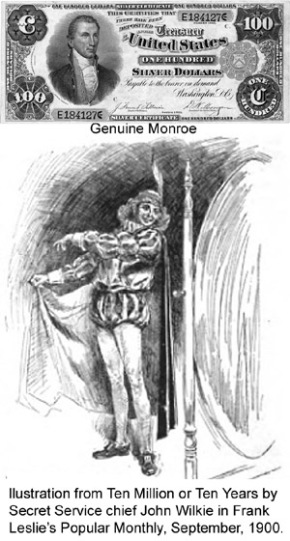This is one of 1122 articles in my book Now and Then Again, The Way We Were and the Way We Are, second edition. The book is available from Amazon for $20.95 print and $9.95 Kindle and also as an ebook from Apple, Kobo, and Scribd for $9.95. It’s fixed format so it’s better with a tablet, laptop, or computer. There are more articles from the book on another blog here. And there is a book preview website .
Passing the Buck
On December 28, 1898, a Monroe head $100 silver certificate sent to the Philadelphia subtreasury (1) aroused the suspicion of a clerk when the red Treasury seal smeared under his damp thumb. The clerk took the bill to Washington where Treasury experts initially passed it as genuine but finally declared it counterfeit when it separated into two pieces when soaked in water (2). Even though Monroe’s cheekbones and hair over the ear weren’t right, the counterfeit was so good that the Treasury had to recall the entire issue, $27 million and the new head of the Secret Service, John Wilkie, was directed by the Secretary of the Treasury to spend all his time on the investigation.
Wilkie assigned the case to his best detective, William Burns. By asking around the trade, Burns determined which engravers had the necessary skills and had ordered certain materials. This led him to Arthur Taylor and Baldwin Bredell, engravers in Philadelphia.
The Secret Service watched the top floor of a building at Ninth and Filbert streets for over a year. One day Taylor and Bredell took a train to Lancaster, shadowed by a Secret Service operative. They visited a large cigar factory there owned by William Jacobs and a tobacco warehouse a block away run by W.L. Kendig.
When informed of this, Wilkie investigated and found that cigars made there had counterfeit revenue stamps on the boxes. But it was decided to continue the investigation until there was enough evidence to also tie Taylor and Bredell to the counterfeit hundred.
Jacobs and Kendig went to lunch together at noon, leaving the warehouse unoccupied. One day detective Burns broke a window in the warehouse with a baseball and boosted a small boy he had brought along from Philadelphia through the broken window. The boy went around to the front and opened a spring door from the inside. Burns went in and and found 27 tons of blue paper used to make the counterfeit stamps, enough for 400 million cigars (3). When Jacobs and Kendig returned they found a weeping boy who said he would pay for the glass if they would let him in to recover his ball, They did and forgave the broken window.
A night reconnaissance up a fire escape by Burns found all the windows at the Philadelphia engraving shop locked. Taylor and Bredell employed an office boy. Burns rented a costume and an agent bumped into the boy on the street and gave him fifty cents to take the package to a hotel and give it to Burns, posing as a theater man, who asked the boy if he’d like to be an extra in a play. The boy was taken to another room where he changed into the costume, then to see an agent posing as the theater manager. Burns took the boy’s keys from his pocket, and “whirled away” in a waiting carriage to the Yale Lock Company nearby, had the office key duplicated, then “whirled back”. (4) Continue reading